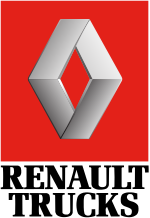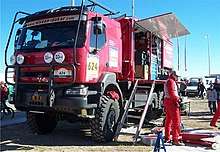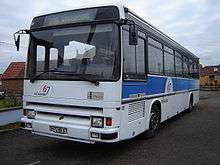Renault Trucks
Renault Trucks is a French commercial truck and military vehicle manufacturer with corporate headquarters at Saint-Priest near Lyon. Originally part of Renault, it has been owned by the Volvo Group, a Swedish multinational manufacturing company, since 2001.
 | |
| Subsidiary | |
| Industry | Automotive |
| Predecessor | Berliet, Saviem |
| Founded | 1978 (as a merger between Saviem and Berliet)[2][3] |
| Founder | Marius Berliet |
| Headquarters | Saint-Priest, France |
Key people |
|
| Products | Trucks, military vehicles |
| Revenue | |
Number of employees | 7,554 (2018)[5] |
| Parent | Volvo |
| Subsidiaries | Renault Trucks Defense |
| Website | renault-trucks |
From its beginnings in 1978 to 2002, the company was called Renault Véhicules Industriels (Renault Industrial Vehicles), from 1992 on officially written as Renault V. I.. Until 1999, Renault Véhicules Industriels also manufactured buses.
History
Renault first began building dedicated commercial trucks in 1906.[6] In 1956, however Renault stopped producing trucks and buses under their own name. Instead, the company Saviem was formed as a subsidiary of their own commercial products with the manufacturers Somua and Latil.[2] Lighter commercials kept on using the Renault name, however. From 1957 on, Saviem was also used as the brand name for the trucks and buses produced by the company.
As a result of French industrial policy, in 1975 state-owned Renault also acquired the truck and bus manufacturer Berliet from Citroën[7] (at that time a part of the Michelin corporation). In 1978, Berliet and Saviem were merged to form Renault Véhicules Industriels. Again, the old brand names were retained for two more years while the model lineups were gradually incorporated, until in 1980 they were replaced by the name Renault.

In 1971, Saviem became a member of the Euro Truck Development Group or Club of Four, a cooperation between four European truck producers (Saviem, Volvo, DAF and Magirus-Deutz, which soon after became a part of Iveco) for the production of medium-sized trucks. Since 1975 the truck models resulting from this cooperation were built by Saviem[8] and later Renault, even until 2001. They were also sold on the North American market as the Mack Mid-Liner or Manager.
In 1978, PSA Group had bought Chrysler's European operations.[9] Included in the deal were commercial vehicle operations in the UK and Spain, which at that time used the brand name Dodge. PSA however sold them on to RVI in 1983, having itself little interest in the commercial vehicle market.[10] The newly acquired operations in the UK had their origins in the commercial vehicle branch of the Rootes Group which originally carried the brand names Karrier and Commer.[11] Some of the models built there were continued in production for several years by RVI in Dunstable, Bedfordshire, who also kept the Dodge brand name for these models, albeit in combination with the Renault badge. In 1988 the company was subject to a Fire Brigades Union inquiry due to 8 Dodge fire engines involved in crashes.[12] Until 1992 the UK division was known as Renault Truck Industries, after which it then took the international Renault V.I. name.
In Spain, however, where Renault already was recognized as a local automobile producer, the Dodge trucks, which originally had been developed by the manufacturer Barreiros Diesel,[13] were rebadged as Renaults and soon after replaced by French-designed models. In 1987, Renault Véhicules Industriels took over from its parent company Renault a 42% stake in the American manufacturer Mack Trucks[14] which became a fully owned subsidiary of Renault Véhicules Industriels in 1990.[15] In 1994, RVI purchased a 34% stake in the Czech bus manufacturer Karosa, increasing its ownership to a majority 51% in 1996 and 96% in 2000.[16] In 1997 Renault V. I. entered into a cooperation agreement with the Finnish truck producer Sisu. In 2002 the company signed a deal with the Chinese company Dongfeng Motor to manufacture engines.[17]
Renault Trucks took part in the FIA European Championship, running Renault Premium powered by 13-litre DXi13 engines. The Renault Trucks-MKR Technology team won in 2010.
Also, the former Uruguayan plant of cars owned by Nordex S.A. in Uruguay, made since 2004 the Renault Trucks models like Midlum series.[18]
The Volvo Group invested about €2 billion to develop a new line of Renault Trucks vehicles (C, D, K, T) which were introduced through 2013 replacing the previous models.[19]
Changes of ownership
As part of Renault's restructuring following privatisation in 1996, the heavy vehicles operations of bus and truck were divested. In 1999, the Renault and Karosa bus and coach operations were split off from Renault Véhicules Industriels and merged with Fiat-Iveco's bus and coach operations to form the jointly owned subsidiary Irisbus.[16] In 2003, Irisbus became a full subsidiary of Iveco and the brand Renault on its products was replaced by the brand Irisbus.
On 2 January 2001, Renault V. I. (including Mack Trucks, but not Renault S. A.'s stake in Irisbus) was sold to Volvo, which renamed it Renault Trucks in 2002.[20] As a result, the mother company Renault S. A. was Volvo's biggest shareholder, with a 20% stake, shares and voting rights, but the majority of this was sold in October 2010, leaving a 5.1% stake.[21] In December 2012, Renault sold its remaining shares in Volvo.[22]
Military vehicles
The Renault Trucks Defense division is wholly owned by Renault Trucks and is based in Versailles, France. It trades on its 1975 acquisition of Berliet and claims to have over 30,000 vehicles in use around the world.[23] Its status as the leading supplier to the French Army was put in jeopardy in 2010 when the government placed a $214m order to Italian competitor Iveco.[24] In 2016, Volvo announced its intention of divesting Renault Trucks Defense, as part of the selling of its Government Sales division.[25]
It manufactures a range of special vehicles aimed at the defense and security markets, including the Sherpa, VAB armoured personnel carrier, AMC armoured multirole carrier and Kerax ranges.
In 2006 Renault Trucks took over ACMAT, but the defence and security vehicle manufacturer retained its own name and identity.
On 24 May 2018, Renault Trucks Defense was renamed as Arquus.[26]
Products
-2003.jpg)



Current products
Delivery range
- Renault Master (Renault-built vehicle sold by Renault Trucks dealerships under a special agreement)[27]
- Renault Maxity (built in Spain as a version of the Nissan Cabstar)
Distribution range
Construction range
Long distance range
Military SUVs
Former truck models
- Dodge 50 Series
- Dodge 100 "Commando"
- Dodge 300 Series
- Renault Access, joint venture with Dennis Eagle, replaced Renault Puncher in 2010[28]
- Renault C
- Renault B (Messenger)
- Renault J
- Renault M/Renault S (Midliner)
- Renault G (Manager/Maxter)
- Renault Kerax
- Renault R (Major)
- Renault Magnum
- Renault Mascott
- Renault Midlum (sold in Australia as Mack Midlum)
- Renault Puncher 280 HP / 20 or 26 tonnes.
- Renault Premium (sold in Australia as Mack Premium, in New Zealand as Mack Quantum)
- Renault Premium Lander
- Renault Premium Route
Former bus models
- Renault PR100, previously sold under the Berliet name, launched in 1972. Some Australian versions of the PR100.2 carried dual Renault and Mack logos
- Renault PR112 was a 1994 upgrade to the PR100 using a front end designed by coachbuilder Safra
- Renault PR180.2 was the articulated version of the PR100, launched in 1981, later to become the Renault PR112 following a facelift
- Renault R312, replaced in 1996 by the Renault Agora, then renamed Irisbus Agora in 2002. In Australia it was sold as the Renault PR100.3
- Renault Recreo school bus built by Karosa
- Renault SC10, initially sold as the Saviem SC10 from 1965, and then in 1981 it was upgraded to the Renault SC10R when the distinctive curved front window was lost. The SC10U, and its replacement SC10RA featured the unique open rear deck.[29]
- Renault Tracer, replaced by Renault Arés in 2000 and renamed Irisbus Arés in 2001
Former coaches models
- Renault E7, originally launched as the Saviem E7 in 1969
- Renault PR14, originally launched in 1974 as the Berliet Crusair
- Renault PR80S, derived from the Renault PR100
- Renault S-Series coach was marketed as Renault (such as the Renault S45), Saviem and Saviem-Chausson during its production period of 1977 to 1993[30]
- Renault FR1, sold for a short time in the US as Mack FR1. Facelifted and renamed Renault Iliade in 1997
Former trolley bus and tram models
- Renault ER100, originally launched under the Berliet name in 1977, replaced by the Irisbus Cristalis
- Renault PER180, diesel-trolleybus hybrid based on the Renault PR180
- Renault Civis was quickly rebranded Irisbus Civis following the sale of Renault Bus
Concept vehicles
- Renault Radiance (2004)
- Renault Magnum Vega
See also
References
- "2013 Renault Trucks Corporate Legal Information". Renault Trucks. Retrieved 7 May 2013.
- Carroll, John; Davies, Peter James (2007). Complete Book Tractors and Trucks. Hermes House. pp. 66–67. ISBN 1-843-09689-7.
- Kolodziej, Edward A. (1983). "France". In Ball, Nicole; Leitenberg, Milton (eds.). The Structure of the Defense Industry: An International Survey. Routledge. p. 85. ISBN 0-7099-1611-6.
- "New management to take Renault Trucks towards strong growth". Renault Trucks UK. Retrieved 2 May 2013.
- "Renault Trucks" (in French). Verif.com. Retrieved 13 July 2017.
- Bradley, Elliot (1979). Trucks and trucking. Crescent Books. p. 94. ISBN 0-517-27343-8.
- Carroll, John; Davies, Peter James (2007). p. 59.
- Davies, Peter J. (2001). An Illustrated A-Z of World Trucks: A Directory of Classic and Contemporary Trucks Around the Globe. Southwater Publishing. p. 169. ISBN 1-842-15459-1.
- Flory, J. (2011). "Appendices". American Cars, 1973–1980: Every Model, Year by Year. McMillan. pp. 892–893. ISBN 978-0-7864-4352-9.
- Kuipers, J. F. J. (1983). Great Trucks. Beekman House. p. 9. ISBN 0-517-38114-1.
- Davies, Peter J. (2001). p. 97.
- Sunday Times (London, England) 5 June 1988
- Davies, Peter J. (2001). p. 45.
- Shope, Dan (28 May 1987). "Mack Shares Shifted at Renault". articles.mcall.com. The Morning Call. Retrieved 1 August 2013.
- Shope, Dan (2 October 1990). "Renault's Buyout Of Mack Puts Bite Back in the Bulldog". articles.mcall.com. The Morning Call. Retrieved 1 August 2013.
- Pavlínek, Petr (2008). "Restructuring of the Czech Commercial Vehicle Industry". A Successful Transformation?: Restructuring of the Czech Automobile Industry. Contributions to Economics. Springer Publishing. p. 151. ISBN 978-3-7908-2039-3.
- bnet.com December 2002
- "Archived copy". Archived from the original on 18 July 2012. Retrieved 6 October 2012.CS1 maint: archived copy as title (link)
- "Press release. New Renault Trucks range: centres of profit serving customers' business". Automotiveworld.com. 12 June 2013. Retrieved 25 June 2013.
- "AB Volvo – press release". Cision Wire. 2 January 2001. Archived from the original on 22 July 2012.
- Financial Times October 7 2010
- "Renault sells remaining Volvo stake". Reuters. 12 December 2012. Retrieved 16 April 2013.
- Renault Trucks Defense website Archived 18 January 2011 at the Wayback Machine
- UPI.com news 5 January 2011
- Tran, Pierre (4 November 2016). "Volvo Launches RTD Sale, No Timetable". Defense News. Retrieved 14 June 2017.
- https://web.archive.org/web/20180911152634/https://www.janes.com/article/80350/renault-trucks-defense-renamed-arquus
- "En 2012, dans un contexte économique difficile, Renault Trucks maintient ses positions et prépare l'avenir" [In 2012, within a difficult economic context, Renault Trucks maintains its position and prepares for the future] (in French). Renault Trucks. Retrieved 2 May 2013.
- Roadtransport.com, July 7, 2010 Archived 13 August 2010 at the Wayback Machine
- French Bus Page website Archived 12 June 2011 at the Wayback Machine
- Bus Explorer website Archived 27 September 2011 at the Wayback Machine
External links
| Wikimedia Commons has media related to Renault trucks. |
- Renault Trucks Global Website
- Renault Trucks Defense website
- Renault Trucks Corporate 2009
- Spanish Renault trucks gallery